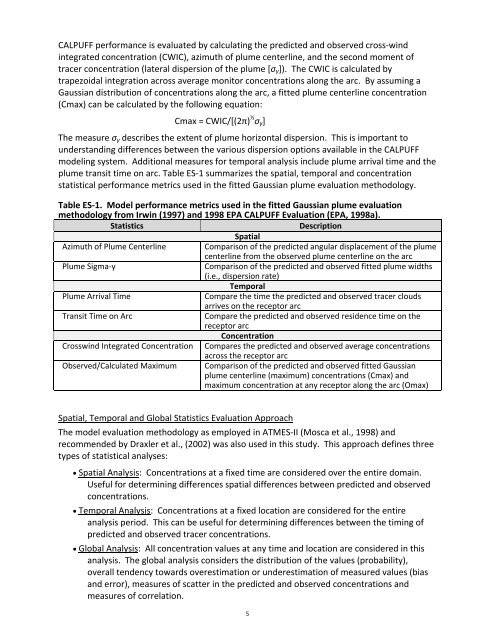Documentation of the Evaluation of CALPUFF and Other Long ...
Documentation of the Evaluation of CALPUFF and Other Long ...
Documentation of the Evaluation of CALPUFF and Other Long ...
Create successful ePaper yourself
Turn your PDF publications into a flip-book with our unique Google optimized e-Paper software.
<strong>CALPUFF</strong> performance is evaluated by calculating <strong>the</strong> predicted <strong>and</strong> observed cross‐wind<br />
integrated concentration (CWIC), azimuth <strong>of</strong> plume centerline, <strong>and</strong> <strong>the</strong> second moment <strong>of</strong><br />
tracer concentration (lateral dispersion <strong>of</strong> <strong>the</strong> plume [σy]). The CWIC is calculated by<br />
trapezoidal integration across average monitor concentrations along <strong>the</strong> arc. By assuming a<br />
Gaussian distribution <strong>of</strong> concentrations along <strong>the</strong> arc, a fitted plume centerline concentration<br />
(Cmax) can be calculated by <strong>the</strong> following equation:<br />
Cmax = CWIC/[(2π) ½ σy]<br />
The measure σy describes <strong>the</strong> extent <strong>of</strong> plume horizontal dispersion. This is important to<br />
underst<strong>and</strong>ing differences between <strong>the</strong> various dispersion options available in <strong>the</strong> <strong>CALPUFF</strong><br />
modeling system. Additional measures for temporal analysis include plume arrival time <strong>and</strong> <strong>the</strong><br />
plume transit time on arc. Table ES‐1 summarizes <strong>the</strong> spatial, temporal <strong>and</strong> concentration<br />
statistical performance metrics used in <strong>the</strong> fitted Gaussian plume evaluation methodology.<br />
Table ES‐1. Model performance metrics used in <strong>the</strong> fitted Gaussian plume evaluation<br />
methodology from Irwin (1997) <strong>and</strong> 1998 EPA <strong>CALPUFF</strong> <strong>Evaluation</strong> (EPA, 1998a).<br />
Statistics Description<br />
Spatial<br />
Azimuth <strong>of</strong> Plume Centerline Comparison <strong>of</strong> <strong>the</strong> predicted angular displacement <strong>of</strong> <strong>the</strong> plume<br />
centerline from <strong>the</strong> observed plume centerline on <strong>the</strong> arc<br />
Plume Sigma‐y Comparison <strong>of</strong> <strong>the</strong> predicted <strong>and</strong> observed fitted plume widths<br />
(i.e., dispersion rate)<br />
Temporal<br />
Plume Arrival Time Compare <strong>the</strong> time <strong>the</strong> predicted <strong>and</strong> observed tracer clouds<br />
arrives on <strong>the</strong> receptor arc<br />
Transit Time on Arc Compare <strong>the</strong> predicted <strong>and</strong> observed residence time on <strong>the</strong><br />
receptor arc<br />
Concentration<br />
Crosswind Integrated Concentration Compares <strong>the</strong> predicted <strong>and</strong> observed average concentrations<br />
across <strong>the</strong> receptor arc<br />
Observed/Calculated Maximum Comparison <strong>of</strong> <strong>the</strong> predicted <strong>and</strong> observed fitted Gaussian<br />
plume centerline (maximum) concentrations (Cmax) <strong>and</strong><br />
maximum concentration at any receptor along <strong>the</strong> arc (Omax)<br />
Spatial, Temporal <strong>and</strong> Global Statistics <strong>Evaluation</strong> Approach<br />
The model evaluation methodology as employed in ATMES‐II (Mosca et al., 1998) <strong>and</strong><br />
recommended by Draxler et al., (2002) was also used in this study. This approach defines three<br />
types <strong>of</strong> statistical analyses:<br />
• Spatial Analysis: Concentrations at a fixed time are considered over <strong>the</strong> entire domain.<br />
Useful for determining differences spatial differences between predicted <strong>and</strong> observed<br />
concentrations.<br />
• Temporal Analysis: Concentrations at a fixed location are considered for <strong>the</strong> entire<br />
analysis period. This can be useful for determining differences between <strong>the</strong> timing <strong>of</strong><br />
predicted <strong>and</strong> observed tracer concentrations.<br />
• Global Analysis: All concentration values at any time <strong>and</strong> location are considered in this<br />
analysis. The global analysis considers <strong>the</strong> distribution <strong>of</strong> <strong>the</strong> values (probability),<br />
overall tendency towards overestimation or underestimation <strong>of</strong> measured values (bias<br />
<strong>and</strong> error), measures <strong>of</strong> scatter in <strong>the</strong> predicted <strong>and</strong> observed concentrations <strong>and</strong><br />
measures <strong>of</strong> correlation.<br />
5

















